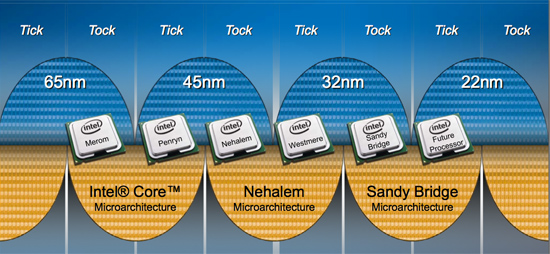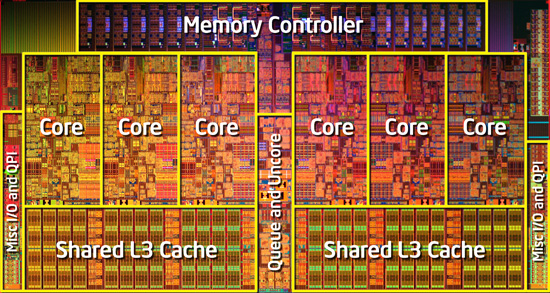Apple Mac Pro (Mid 2010) Review
by Anand Lal Shimpi on October 6, 2010 9:26 PM ESTCPU Options
Intel continues to sell both 45nm Nehalem based Xeons as well as 32nm Westmere models. As a result, Apple offers both in its new Mac Pro lineup. If you aren't familiar with the two architectures have a look here and here.

The entry level single-socket quad-core uses a Nehalem Xeon, the rest of the lineup (all six-core and two-socket quad-core) uses Westmere based Xeons. As a result, the single-socket quad-core Mac Pro has an 8MB L3 cache while the rest have 12MB L3 caches (as well as the other Westmere enhancements). Unfortunately Apple is still slow to adopt AES-NI so one of the major Westmere features goes unused in OS X.

There are other differences between platforms. The quad-core options (Nehalem and Westmere) all support DDR3-1066, only the six-core CPUs support DDR3-1333.
The added cache should help performance but the bigger improvement will be in power consumption. You'll be able to get more cores at the same power levels as the Nehalem Mac Pro, or the same number of cores at lower power.
The single socket systems use a physically different CPU/memory daughterboard, so there’s no hope for those wanting to simply stick in another CPU down the road.
Turbo is still alive and well but the frequency gains aren’t all that great. The single socket quad-core runs at 2.8GHz and can turbo up to 3.06GHz, while the eight-core configuration starts at 2.40GHz and can only turbo up to 2.66GHz.
Roadmap
With the arrival of Sandy Bridge imminent, you might ask - why buy a Mac Pro today? And I might answer, Sandy Bridge isn't imminent for everybody.
In 2008 Intel introduced the Nehalem based Xeon and Core i7 CPUs. This architecture was the basis for the original Mac Pro. From 2008 through the end of 2009, Nehalem was not replaced at the top of the processor stack. There were more affordable derivatives (Lynnfield), but nothing usurped Nehalem's role as the top dog. Having just been updated last year, Lynnfield skipped an upgrade in 2010 and instead we saw Nehalem's replacement (Westmere, in the new Mac Pro) and new dual-core offerings (in the new MacBook/MacBook Pro). When Sandy Bridge arrives in early 2011, it won't replace any 6-core offerings in the product stack. You'll see some very competitive quad-core CPUs, but if you need more threads you'll have to wait.

How long? Probably until Q4 2011 at the absolute earliest for 8-core Sandy Bridge based parts. Apple could update the entry level quad-core Mac Pro to Sandy Bridge before the middle of next year however.










84 Comments
View All Comments
khimera2000 - Sunday, October 10, 2010 - link
Dont forget that the reason why mac is more linux/unix friendly is becaus they bucherd the open source comunity to put out a OS that can compete rather then starting from the ground up :D check it out its out there ;)BrooksT - Thursday, October 7, 2010 - link
They use the same documentation for the Mac Pros as they do for Macbooks? Ouch. That must suck to be a service tech on a Mac Pro.What you're missing is that it's not the cost of making the 10,000th unit that matters. Making the *first* one is very very expensive. Sure, the gross margins are quite high -- probably 50%, compared to Apple's average of 38%.
But for Dell, and Apple, and any other large manufacturer, there is a lot more to this than "putting the system together." That is the cheapest and easiest part of the whole process. But if assembly is the only the value you see them adding, by all means, you're better off buying parts and doing it yourself. Other people see value in a single point of contact, whole systems validated to work together, and even pretty design.
xype - Thursday, October 7, 2010 - link
What parts of the Mac Pro internals look like random components compiled to a list by an "engineer"? Do they use an ASUS motherboard? Antec case? Artic cooling vents? Vanilla cabling? Have you actually ever looked inside a Mac Pro, much less upgraded any part of it?Sure, there's a big markup on those machines, but throwing either the Mac Pro or the Dell/HP workstations into the same lot as a randomly-assembled PC is making your argument look stupid. As for the money saved: people who tax-deduct their computers usually don't care. Coincidentally, they are the target audience for those machines.
rafaperez3d - Friday, October 8, 2010 - link
What is the problem with those components? ASUS making motherboards? Arctic making coolers? They are very good at they do, and usually they do that longer than Apple....Anyway, if you look closely, Apple basically do the chassis... I think even motherboard is from Intel...
seanleeforever - Thursday, October 7, 2010 - link
@mattgmannyou know, what you have done is perfectly fine but is ONLY applicable to home-brow, small scale, no regulation applications such as what you have just described.
please don't take it personal, but a large business has set of regulation and rules that you obviously don't even be bothered with.
for example, you said those are off the shelf components, okay, find me a off the shelf components that shapes like Mac book pro sheet metal, or M/B that fit like what Apple have? how about heat sink? see what i did here? just because the system you put together use all the COTS parts, doesn't mean everyone use COTS parts. what you did is simply putting stuff together (or like you said, just a minimum wage factory worker to slap together off the shelf components). anything new will require you to design the parts and make sure them fit. this is not a simple task by any stretch of imagination.
"'documentation, marketing effort, customer support etc'. These are all things that apply to every system they make and the costs are no different. I think these are more apologistic excuses rather than actual reasons."
this statement is completely false in a large scale. let's assume you get hit by a car tomorrow and hospitalized. one of your machine has power problems and causing reboots. okay, do you keep a set of document for machine you built? like what CPU/Video card/HDD/RAM... if i ask you that what is your power consumption under certain load, do you have a document to show me? does your document good enough to help engineer diagnose the error? if a batch of video card is faulty, can you trace which system you build may or will be affected?
let's move on the QA too, what is your quality assurance? is there a process in place to make sure all the unit you build will have the same quality?
those just a few things a large business has to consider, you are not selling 200, you are selling 200k. YOU will not be able to answer all the tech calls and fix all machines. your customer will have all sort of questions cover all areas. this is a HUGE effort.
erple2 - Friday, October 8, 2010 - link
You're only seeing a small part of the overall cost. The cost of a support staff to price out, then buy, then assemble, then burn-in a machine for a company is just staggering. And it's not for the cost of the support staff. You have to also factor in the cost of the people downstream that are "waiting" for the upgraded hardware, too.My personal time is more or less "worthless" to me - I can easily substitute a substantial amount of my own time to crawling through newegg or other sites to part out the best bang for the buck computer that I want to use at home. However, if I was making purchasing decisions for a company/business, I'd have to factor in the delay costs of crawling through various sites looking for the best deal, compared with the time that I'm wasting from other people to be using that product. Even if I only cost 50 bucks an hour, there may be 30 other people that are also costing 50 bucks per hour. That's 1500 dollars per hour of lost productivity, just in getting parts ready to burnin and test. How many hours does it take before it no longer makes financial sense to just buy a pre-made system?
There is a very very good reason why medium and large companies that don't have regular "the server is down" events use pre-made machines sourced from a single vendor. Support costs are astronomical, once you actually factor in the TRUE cost of ownership over the life of the parts.
I am about 90% sure that every single person who claims that the Mac Pro is an overpriced PC have never actually done anything remotely similar to a cost analysis on the actual costs of computer ownership. If your time is free, then it doesn't matter. But nobody that runs a business, or works in a business can say that.
pieterjan - Thursday, October 7, 2010 - link
You're an idiot if you buy Precision workstations at list price. Give Dell a call, and ask for a discount. You'll also be able to configure these systems to your likings: more parts options. This is especially true if you say them, that if you're satisfied, more purchases from Dell will follow.Sabresiberian - Thursday, October 7, 2010 - link
I'm so impressed that you can call people names, and put people down who are medically and/or educationally diagnosed "retarded" at the same time. There's nothing wrong with being retarded, there is something wrong with being rude and unkind.Others have addressed the issue, but I'll add that it's not about how you "can't understand" the "premium", it's about you not finding out why business people are willing to pay the price - it's not just about bigger budgets and throwing money at solutions. You CAN understand if you'll make the effort to do so.
Then, if you still really think you can provide the same product for less, you can get into business for yourself and make some money. :D
mattgmann - Thursday, October 7, 2010 - link
I make lots of money building custom workstations for small businesses. It's a nice side job. They get systems to fit their exact needs and save a butt load of cash. I take care of all hardware warranties, and software support comes from the software manufacturer. Of about 200 systems I've built over the last few years that are floating around the city, I've made exactly 2 service calls, and spent less than an hour per system on the phone.The "premium" should be in a properly configured system, not in a phone number to a dell genius or apple savant to help you fix your system. Knowing how you use it is the end users job. All of this "premium" crap is overrated and a waste of money. I more than understand the decision process, and as a business owner I know that production is what matters. I'd rather spend that extra money on training for employees than waste it on meaningless support.
Did I hurt your feelings with my words? Can't take a little sarcasm? Thanks for the heartfelt scolding; I'll try not to use anymore "offensive" words. Now go back to your desk in human resources and file some more sexual harassment complaints. This is an internet message board, not a world peace and hugs meeting.
AnnonymousCoward - Thursday, October 7, 2010 - link
Is that $250 Obsidian case really necessary, or would an $80 work just as well? cuz that really brings up your custom price.